Spiceland 10e TB Chapter 01 Final PDF

| Title | Spiceland 10e TB Chapter 01 Final |
|---|---|
| Author | Albert Jose |
| Course | Intermediate Accounting III |
| Institution | Universidad Interamericana de Puerto Rico |
| Pages | 51 |
| File Size | 574.7 KB |
| File Type | |
| Total Downloads | 60 |
| Total Views | 138 |
Summary
test bank...
Description
Intermediate Accounting, 10e (Spiceland) Chapter 1 Environment and Theoretical Structure of Financial Accounting 1) The primary function of financial accounting is to provide relevant financial information to parties external to business enterprises. Answer: TRUE Difficulty: 1 Easy Topic: Environment of financial accounting and reporting Learning Objective: 01-01 Describe the function and primary focus of financial accounting. Blooms: Remember AACSB: Reflective Thinking AICPA: BB Critical thinking
2) Accrual accounting attempts to measure revenues and expenses that occurred during accounting periods so they equal net operating cash flow. Answer: FALSE Difficulty: 1 Easy Topic: Cash versus accrual accounting Learning Objective: 01-02 Explain the difference between cash and accrual accounting. Blooms: Understand AACSB: Reflective Thinking AICPA: FN Measurement
3) The FASB is currently the public-sector organization responsible for setting accounting standards in the United States. Answer: FALSE Difficulty: 1 Easy Topic: Development of accounting and reporting standards Learning Objective: 01-03 Define generally accepted accounting principles (GAAP) and discuss the historical development of accounting standards, including convergence between U.S. and international standards. Blooms: Remember AACSB: Reflective Thinking AICPA: BB Legal
4) The FASB's due process invites various interested parties to indicate their opinions about whether financial accounting standards should be changed. Answer: TRUE Difficulty: 1 Easy Topic: GAAP―Standard-setting process Learning Objective: 01-04 Explain why establishing accounting standards is characterized as a political process. Blooms: Remember AACSB: Reflective Thinking AICPA: BB Legal
5) Accounting for stock-based compensation is an area in which the FASB has received little political interference. Answer: FALSE Difficulty: 1 Easy Topic: GAAP―Standard-setting process
1 Copyright ©2021 McGraw-Hill
Learning Objective: 01-04 Explain why establishing accounting standards is characterized as a political process. Blooms: Remember AACSB: Reflective Thinking AICPA: BB Legal
6) The Public Reform and Investor Protection Act of 2002 (Sarbanes-Oxley) changed the entity responsible for setting standards for auditing public companies in the United States. Answer: TRUE Difficulty: 1 Easy Topic: Encouraging high-quality financial reporting Learning Objective: 01-05 Explain factors that encourage high-quality financial reporting. Blooms: Remember AACSB: Reflective Thinking AICPA: BB Legal
7) A rules-based approach to standard-setting stresses professional judgment as opposed to following a list of rules. Answer: FALSE Difficulty: 1 Easy Topic: Encouraging high-quality financial reporting Learning Objective: 01-05 Explain factors that encourage high-quality financial reporting. Blooms: Remember AACSB: Reflective Thinking AICPA: BB Critical thinking
8) Under federal securities laws, the SEC has the authority to set accounting standards in the United States. Answer: TRUE Difficulty: 1 Easy Topic: Development of accounting and reporting standards Learning Objective: 01-03 Define generally accepted accounting principles (GAAP) and discuss the historical development of accounting standards, including convergence between U.S. and international standards. Blooms: Remember AACSB: Reflective Thinking AICPA: BB Legal
9) The primary responsibility for properly applying GAAP when communicating with investors and creditors through financial statements lies with a firm's auditors. Answer: FALSE Difficulty: 1 Easy Topic: Encouraging high-quality financial reporting Learning Objective: 01-05 Explain factors that encourage high-quality financial reporting. Blooms: Remember AACSB: Reflective Thinking AICPA: BB Critical thinking
10) Auditors play an important role in the resource allocation process by adding credibility to financial statements. Answer: TRUE 2 Copyright ©2021 McGraw-Hill
Difficulty: 1 Easy Topic: Encouraging high-quality financial reporting Learning Objective: 01-05 Explain factors that encourage high-quality financial reporting. Blooms: Understand AACSB: Reflective Thinking AICPA: BB Critical thinking
11) The purpose of the conceptual framework is to provide a structure and framework for a consistent set of GAAP. Answer: TRUE Difficulty: 1 Easy Topic: Conceptual framework―Purpose Learning Objective: 01-06 Explain the purpose of the conceptual framework. Blooms: Remember AACSB: Reflective Thinking AICPA: BB Critical thinking
12) In the United States, the conceptual framework indicates GAAP when a more specific accounting standard does not apply. Answer: FALSE Difficulty: 1 Easy Topic: Conceptual framework―Purpose Learning Objective: 01-06 Explain the purpose of the conceptual framework. Blooms: Remember AACSB: Reflective Thinking AICPA: BB Critical thinking
13) Materiality can be affected by the dollar amount of an item, the nature of the item, or both. Answer: TRUE Difficulty: 1 Easy Topic: Concepts―Qualitative characteristics Learning Objective: 01-07 Identify the objective and qualitative characteristics of financial reporting information, and the elements of financial statements. Blooms: Remember AACSB: Reflective Thinking AICPA: BB Critical thinking AICPA: FN Measurement
14) According to the FASB's Statements of Financial Accounting Concepts, conservatism is a desired qualitative characteristic of accounting information. Answer: FALSE Difficulty: 1 Easy Topic: Concepts―Qualitative characteristics Learning Objective: 01-07 Identify the objective and qualitative characteristics of financial reporting information, and the elements of financial statements. Blooms: Remember AACSB: Reflective Thinking AICPA: BB Critical thinking AICPA: FN Measurement
15) Equity is a residual amount representing the owner's interest in the assets of the business. 3 Copyright ©2021 McGraw-Hill
Answer: TRUE Difficulty: 1 Easy Topic: Concepts―Elements of financial statements Learning Objective: 01-07 Identify the objective and qualitative characteristics of financial reporting information, and the elements of financial statements. Blooms: Remember AACSB: Reflective Thinking AICPA: BB Critical thinking AICPA: FN Measurement
16) Revenues are inflows of assets or settlements of liabilities from activities that constitute the entity's ongoing operations. Answer: TRUE Difficulty: 1 Easy Topic: Concepts―Elements of financial statements Learning Objective: 01-07 Identify the objective and qualitative characteristics of financial reporting information, and the elements of financial statements. Blooms: Remember AACSB: Reflective Thinking AICPA: BB Critical thinking AICPA: FN Measurement
17) Gains or losses result, respectively, from the disposition of business assets for greater than, or less than, their book values. Answer: TRUE Difficulty: 1 Easy Topic: Concepts―Elements of financial statements Learning Objective: 01-07 Identify the objective and qualitative characteristics of financial reporting information, and the elements of financial statements. Blooms: Remember AACSB: Reflective Thinking AICPA: BB Critical thinking AICPA: FN Measurement
18) Comprehensive income is another term for net income. Answer: FALSE Difficulty: 1 Easy Topic: Concepts―Elements of financial statements Learning Objective: 01-07 Identify the objective and qualitative characteristics of financial reporting information, and the elements of financial statements. Blooms: Remember AACSB: Reflective Thinking AICPA: BB Critical thinking AICPA: FN Measurement
19) The FASB's conceptual framework lists relevance and timeliness as the two fundamental qualitative characteristics of decision-useful information. Answer: FALSE Difficulty: 1 Easy Topic: Concepts―Qualitative characteristics Learning Objective: 01-07 Identify the objective and qualitative characteristics of financial reporting information, and the
4 Copyright ©2021 McGraw-Hill
elements of financial statements. Blooms: Remember AACSB: Reflective Thinking AICPA: BB Critical thinking AICPA: FN Measurement
20) The monetary unit assumption requires that items in financial statements be measured in a particular monetary unit. Answer: TRUE Difficulty: 1 Easy Topic: GAAP―Underlying assumptions Learning Objective: 01-08 Describe the four basic assumptions underlying GAAP. Blooms: Remember AACSB: Reflective Thinking AICPA: BB Critical thinking AICPA: FN Measurement
21) The periodicity assumption requires that present value calculations take into account the number of compounding periods in each year. Answer: FALSE Difficulty: 1 Easy Topic: GAAP―Underlying assumptions Learning Objective: 01-08 Describe the four basic assumptions underlying GAAP. Blooms: Remember AACSB: Reflective Thinking AICPA: BB Critical thinking AICPA: FN Measurement
22) Determining fair value by calculating the present value of future cash flows is a level 1 type of input. Answer: FALSE Difficulty: 1 Easy Topic: Concepts―Recognition - Measurement - Disclosure Learning Objective: 01-09 Describe the recognition, measurement, and disclosure concepts that guide accounting practice. Blooms: Remember AACSB: Reflective Thinking AICPA: BB Critical thinking AICPA: FN Measurement
23) The FASB's framework for measuring fair value doesn't change the situations in which fair value is used under current GAAP. Answer: TRUE Difficulty: 1 Easy Topic: Concepts―Recognition - Measurement - Disclosure Learning Objective: 01-09 Describe the recognition, measurement, and disclosure concepts that guide accounting practice. Blooms: Remember AACSB: Reflective Thinking AICPA: BB Critical thinking AICPA: FN Measurement
24) The revenue/expense approach emphasizes determining the appropriate amounts of revenue and expense in each reporting period. 5 Copyright ©2021 McGraw-Hill
Answer: TRUE Difficulty: 1 Easy Topic: Evolving GAAP Learning Objective: 01-10 Contrast a revenue/expense approach and an asset/liability approach to accounting standard setting. Blooms: Remember AACSB: Reflective Thinking AICPA: BB Critical thinking AICPA: FN Measurement
25) The asset/liability approach emphasizes matching to determine what assets and liabilities should be reflected on the balance sheet. Answer: FALSE Difficulty: 1 Easy Topic: Evolving GAAP Learning Objective: 01-10 Contrast a revenue/expense approach and an asset/liability approach to accounting standard setting. Blooms: Remember AACSB: Reflective Thinking AICPA: BB Critical thinking AICPA: FN Measurement
26) In IFRS, the conceptual framework indicates appropriate accounting when a more specific accounting standard does not apply. Answer: TRUE Difficulty: 1 Easy Topic: International Financial Reporting Standards Learning Objective: 01-11 Discuss the primary differences between U.S. GAAP and IFRS with respect to the development of accounting standards and the conceptual framework underlying accounting standards. Blooms: Remember AACSB: Diversity AICPA: BB Global
27) Political pressure never affects the IFRS standard-setting process. Answer: FALSE Difficulty: 1 Easy Topic: International Financial Reporting Standards Learning Objective: 01-11 Discuss the primary differences between U.S. GAAP and IFRS with respect to the development of accounting standards and the conceptual framework underlying accounting standards. Blooms: Remember AACSB: Diversity AICPA: BB Global AICPA: BB Legal
28) External decision makers would not look primarily to financial accounting information to assist them in making decisions on: A) Granting credit. B) Capital budgeting. C) Selecting stocks. D) Mergers and acquisitions. 6 Copyright ©2021 McGraw-Hill
Answer: B Difficulty: 1 Easy Topic: Environment of financial accounting and reporting Learning Objective: 01-01 Describe the function and primary focus of financial accounting. Blooms: Understand AACSB: Reflective Thinking AICPA: BB Resource management
29) The primary focus for financial accounting information is to provide information useful for:
a. b. c. d.
Investing decisions Yes Yes No No
Credit decisions Yes No Yes No
A) Option a. B) Option b. C) Option c. D) Option d. Answer: A Difficulty: 1 Easy Topic: Environment of financial accounting and reporting Learning Objective: 01-01 Describe the function and primary focus of financial accounting. Blooms: Remember AACSB: Reflective Thinking AICPA: BB Resource management AICPA: FN Risk analysis
30) Which of the following groups is not among the external users for whom financial statements are prepared? A) Customers. B) Suppliers. C) Employees. D) Customers, suppliers, and employees are all external users of financial statements. Answer: D Difficulty: 1 Easy Topic: Environment of financial accounting and reporting Learning Objective: 01-01 Describe the function and primary focus of financial accounting. Blooms: Remember AACSB: Reflective Thinking AICPA: BB Critical thinking AICPA: FN Risk analysis
31) Which of the following is not true about net operating cash flow? A) It is the difference between cash receipts and cash disbursements from providing goods and services. B) It is a measure used in accrual accounting and is recognized as the best predictor of future operating cash flows. 7 Copyright ©2021 McGraw-Hill
C) Over short periods, it may not be indicative of long-run cash-generating ability. D) It is easy to understand and all information required to measure it is factual. Answer: B Difficulty: 2 Medium Topic: Cash versus accrual accounting Learning Objective: 01-02 Explain the difference between cash and accrual accounting. Blooms: Remember AACSB: Reflective Thinking AICPA: BB Critical thinking AICPA: FN Measurement
32) Which of the following groups is not among financial intermediaries? A) Mutual fund managers. B) Financial analysts. C) CPAs. D) Credit rating organizations. Answer: C Difficulty: 2 Medium Topic: Environment of financial accounting and reporting Learning Objective: 01-01 Describe the function and primary focus of financial accounting. Blooms: Remember AACSB: Reflective Thinking AICPA: BB Critical thinking AICPA: FN Measurement
33) Which of the following was the first private-sector entity that set accounting standards in the United States? A) Accounting Principles Board. B) Committee on Accounting Procedure. C) Financial Accounting Standards Board. D) AICPA. Answer: B Difficulty: 2 Medium Topic: Development of accounting and reporting standards Learning Objective: 01-03 Define generally accepted accounting principles (GAAP) and discuss the historical development of accounting standards, including convergence between U.S. and international standards. Blooms: Remember AACSB: Reflective Thinking AICPA: BB Legal
34) Which of the following does not provide guidance about GAAP for companies that are publicly listed on a stock exchange? A) FASB B) IASB C) GASB D) EITF Answer: C Difficulty: 1 Easy
8 Copyright ©2021 McGraw-Hill
Topic: Development of accounting and reporting standards Learning Objective: 01-03 Define generally accepted accounting principles (GAAP) and discuss the historical development of accounting standards, including convergence between U.S. and international standards. Blooms: Remember AACSB: Reflective Thinking AICPA: BB Legal
35) Porite Company recognizes revenue in the period in which it records an asset for the related account receivable, rather than in the period in which the account receivable is collected in cash. Porite's practice is an example of: A) Cash basis accounting. B) Accrual accounting. C) The matching principle. D) Economic entity. Answer: B Difficulty: 1 Easy Topic: Cash versus accrual accounting Learning Objective: 01-02 Explain the difference between cash and accrual accounting. Blooms: Evaluate AACSB: Analytical Thinking AICPA: FN Measurement
36) Which of the following is not a potential benefit of accrual accounting, compared to cashbasis accounting? A) Timeliness. B) Better reflecting economic activity. C) Periodicity. D) Better matching of revenues and expenses. Answer: C Difficulty: 1 Easy Topic: Cash versus accrual accounting Learning Objective: 01-02 Explain the difference between cash and accrual accounting. Blooms: Understand AACSB: Reflective Thinking AICPA: BB Critical thinking AICPA: FN Measurement
37) In a recent annual report, Apple Computer reported the following in one of its disclosure notes: "Warranty Expense: The Company provides currently for the estimated cost for product warranties at the time the related revenue is recognized." This note exemplifies Apple's use of: A) Conservatism. B) Matching. C) Revenue recognition. D) Economic entity. Answer: B Difficulty: 2 Medium Topic: Concepts―Recognition - Measurement - Disclosure Learning Objective: 01-09 Describe the recognition, measurement, and disclosure concepts that guide accounting practice. Blooms: Evaluate AACSB: Analytical Thinking
9 Copyright ©2021 McGraw-Hill
AICPA: BB Critical thinking
38) GAAP is an abbreviation for: A) Generally authorized accounting procedures. B) Generally applied accounting procedures. C) Generally accepted auditing practices. D) Generally accepted accounting principles. Answer: D Difficulty: 1 Easy Topic: Development of accounting and reporting standards Learning Objective: 01-03 Define generally accepted accounting principles (GAAP) and discuss the historical development of accounting standards, including convergence between U.S. and international standards. Blooms: Remember AACSB: Reflective Thinking AICPA: BB Legal
39) The FASB issues accounting standards in the form of: A) Accounting Research Bulletins. B) Accounting Standards Updates. C) Financial Accounting Standards. D) Financial Technical Bulletins. Answer: B Difficulty: 1 Easy Topic: Development of accounting and reporting standards Learning Objective: 01-03 Define generally accepted accounting principles (GAAP) and discuss the historical development of accounting standards, including convergence between U.S. and international standards. Blooms: Remember AACSB: Reflective Thinking AICPA: BB Legal
40) Pronouncements issued by the Committee on Accounting Procedures: A) Dealt with specific accounting and reporting problems. B) Were based on exposure drafts and public comment letters. C) Originated from congressional studies and SEC directives. D) Were the outcome of research studies and a theoretical framework. Answer: A Difficulty: 1 Easy Topic: Development of accounting and reporting standards Learning Objective: 01-03 Define generally accepted accounting principles (GAAP) and discuss the historical development of accounting standards, including convergence between U.S. and international standards. Blooms: Remember AACSB: Reflective Thinking AICPA: BB Legal
41) The FASB's standard-setting process includes, in the correct order: A) Exposure draft, research, discussion paper, Accounting Standards Update. B) Research, exposure draft, discussion paper, Accounting Standards Update. C) Research, discussion paper, exposure draft, Accounting Standards Update. D) Discussion paper, research, exposure draft, Accounting Standards Update. 10 Copyright ©2021 McGraw-Hill
Answer: C Difficulty: 1 Easy Topic: GAAP―Standard-setting process Learning Objective: 01-04 Explain why establishing accounting standards is characterized as a political process. Blooms: Remember AACSB: Reflective Thinking AICPA: BB Legal
42) Which of the following is not a provision of the Public Company Accounting Reform and Investor Protection Act of 2002 (Sarbanes-Oxley)? The Act: A) Changed the entity responsible for setting auditing standards. B) Increased corporate executive responsibility for financial statements. C) Limited nonaudit services that can be performed by auditors for audit clients. D) Cha...
Similar Free PDFs
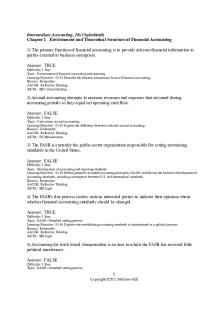
Spiceland 10e TB Chapter 01 Final
- 51 Pages
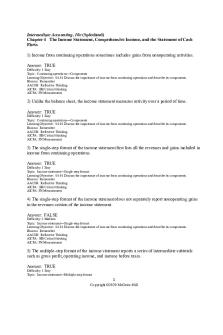
Spiceland 10e TB Chapter 04 Final
- 105 Pages

Spilker 10e Chapter 01 TB
- 17 Pages

Spilker 10e Chapter 02 TB
- 16 Pages

Spilker 10e Chapter 04 TB
- 18 Pages

Spilker 10e Chapter 06 TB
- 17 Pages

Spilker 10e Chapter 05 TB
- 21 Pages

Libby 10E Chapter 01 -q1
- 3 Pages
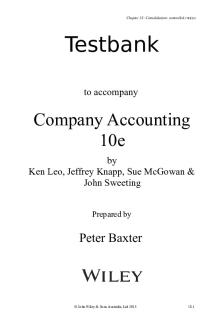
Ch18 tb leo 10e - Ch18 tb leo 10e
- 16 Pages
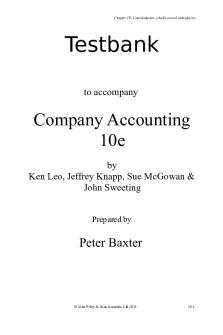
Ch19 tb leo 10e - Ch19 tb leo 10e
- 17 Pages
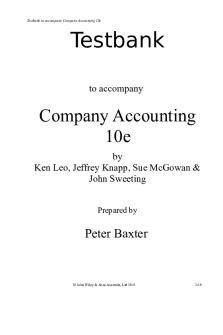
Ch24 tb leo 10e - Ch24 tb leo 10e
- 15 Pages

Edmonds 5e Chapter 01 TB
- 31 Pages

Ross12e chapter 01 tb answerkey
- 24 Pages

Marshall 3e chapter 01 tb
- 14 Pages

Garrison 16e chapter 01 tb
- 88 Pages
Popular Institutions
- Tinajero National High School - Annex
- Politeknik Caltex Riau
- Yokohama City University
- SGT University
- University of Al-Qadisiyah
- Divine Word College of Vigan
- Techniek College Rotterdam
- Universidade de Santiago
- Universiti Teknologi MARA Cawangan Johor Kampus Pasir Gudang
- Poltekkes Kemenkes Yogyakarta
- Baguio City National High School
- Colegio san marcos
- preparatoria uno
- Centro de Bachillerato Tecnológico Industrial y de Servicios No. 107
- Dalian Maritime University
- Quang Trung Secondary School
- Colegio Tecnológico en Informática
- Corporación Regional de Educación Superior
- Grupo CEDVA
- Dar Al Uloom University
- Centro de Estudios Preuniversitarios de la Universidad Nacional de Ingeniería
- 上智大学
- Aakash International School, Nuna Majara
- San Felipe Neri Catholic School
- Kang Chiao International School - New Taipei City
- Misamis Occidental National High School
- Institución Educativa Escuela Normal Juan Ladrilleros
- Kolehiyo ng Pantukan
- Batanes State College
- Instituto Continental
- Sekolah Menengah Kejuruan Kesehatan Kaltara (Tarakan)
- Colegio de La Inmaculada Concepcion - Cebu
